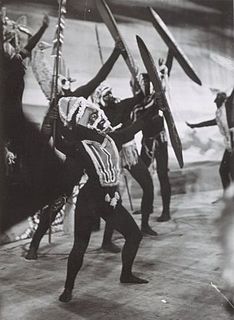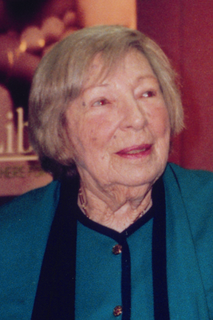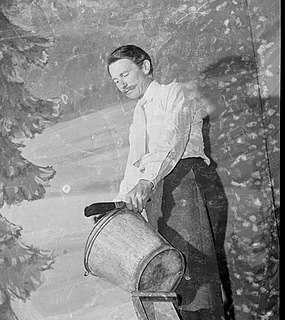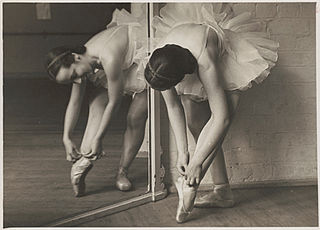Graeme Lloyd Murphy AO is an Australian choreographer. With his fellow dancer Janet Vernon, he guided Sydney Dance Company to become one of Australia's most successful and best-known dance companies.

Romeo and Juliet, Op. 64, is a ballet by Sergei Prokofiev based on William Shakespeare's play Romeo and Juliet. First composed in 1935, it was substantially revised for its Soviet premiere in early 1940. Prokofiev reused music from the ballet in three suites for orchestra and a solo piano work.

Bangarra Dance Theatre is an Aboriginal and Torres Strait Islander dance company focused on contemporary dance. It was founded by African American dancer and choreographer Carole Y. Johnson, Gumbaynggirr man Rob Bryant, and South African-born Cheryl Stone. Stephen Page was artistic director from 1991 to 2021, with Frances Rings taking over in 2022.

John Henry Antill, CMG, OBE was an Australian composer best known for his ballet Corroboree.
Sir Eugene Aynsley Goossens was an English conductor and composer.
Stephen George Page is an Australian choreographer, film director and former dancer. He is the current artistic director of the Bangarra Dance Theatre, an Indigenous Australian dance company. Page is descended from the Nunukul people and the Munaldjali of the Yugambeh people from southeast Queensland, Australia.
Ceremonial dancing has a very important place in the Indigenous cultures of Australia. They vary from place to place, but most ceremonies combine dance, song, rituals and often elaborate body decorations and costumes. The different body paintings indicate the type of ceremony being performed. They play an important role in marriage ceremonies, in the education of Indigenous children, as well as storytelling and oral history. The term corroboree is commonly used to refer to Australian Aboriginal dances, although this term has its origins among the people of the Sydney region. In some places, Aboriginal people perform corroborees for tourists. In the latter part of the 20th century the influence of Indigenous Australian dance traditions has been seen with the development of concert dance, with the Aboriginal Centre for the Performing Arts (ACPA) providing training in contemporary dance.

The Arts in Australia refers to the visual arts, literature, performing arts and music in the area of, on the subject of, or by the people of the Commonwealth of Australia and its preceding Indigenous and colonial societies. Indigenous Australian art, music and story telling attaches to a 40–60,000-year heritage and continues to affect the broader arts and culture of Australia. During its early western history, Australia was a collection of British colonies, therefore, its literary, visual and theatrical traditions began with strong links to the broader traditions of English and Irish literature, British art and English and Celtic music. However, the works of Australian artists – including Indigenous as well as Anglo-Celtic and multicultural migrant Australians – has, since 1788, introduced the character of a new continent to the global arts scene – exploring such themes as Aboriginality, Australian landscape, migrant and national identity, distance from other Western nations and proximity to Asia, the complexities of urban living and the "beauty and the terror" of life in the Australian bush.

Theatre of Australia refers to the history of the performing arts in Australia, or produced by Australians. There are theatrical and dramatic aspects to a number of Indigenous Australian ceremonies such as the corroboree. During its colonial period, Australian theatrical arts were generally linked to the broader traditions of English literature and to British and Irish theatre. Australian literature and theatrical artists have over the last two centuries introduced the culture of Australia and the character of a new continent to the world stage.
Dame Catherine Margaret Mary Scott, was a South African-born pioneering ballet dancer who found fame as a teacher, choreographer, and school administrator in Australia. As the first director of the Australian Ballet School, she is recognised as one of the founders of the strong ballet tradition of her adopted country.

Phillipena (Ena) Noël, best known by the name Ena Noël, was an inspirational school teacher and advocate for children's literature and library services to children and young adults. Ena Noël's name is synonymous in Australia with children's literature and with IBBY, the International Board on Books for Young People. In Australia, she is still affectionately known as 'Mrs IBBY'.

Hélène Kirsova was a Danish prima ballerina, choreographer and ballet teacher and is noted as the founder of the first professional ballet company in Australia. She trained in Paris with former Sergei Diaghilev ballet dancers and choreographers. She then performed in companies run by Léo Staats and Ida Rubinstein before in 1931 becoming a soloist with Les Ballets Russes de Monte Carlo, dancing for several years in Europe and North America. In 1936, as a principal dancer, she joined René Blum's Les Ballets de Monte-Carlo in which she scored a singular success in London. Later that year she joined Colonel Wassily de Basil's Monte Carlo Russian Ballet as prima ballerina on an extensive tour of Australia and New Zealand where she was fêted by critics and audiences. She remained in Australia, started a ballet school in Sydney, and in 1941 formed the Kirsova Ballet. Despite wartime restrictions she directed the company for several years before retiring in 1948. She has been described as the "Godmother" of Australian ballet.

William Henry Archibald Constable was a leading Australian film and stage designer, painter, cartoonist, printmaker and illustrator.

Jean Garling (1907–1998) was an Australian writer, dancer, and for many years a strong supporter of dance and the performing arts, in Sydney, New South Wales. She was a founding member of the Library Society, and became a Governor Benefactor of the State Library of New South Wales in 1992, subsequently bequeathing her whole estate to the Library upon her death in 1998.
Loudon Sainthill was an Australian artist and stage and costume designer. He worked predominantly in the United Kingdom, where he died. His early designs were described as 'opulent', 'sumptuous' and 'exuberantly splendid', but there was also a 'special quality of enchantment, mixed so often with a haunting sadness'.
G'day Digger! is a 1958 televised Australian ballet. It was the first complete Australian ballet to be broadcast by the ABC. Peter Page directed. It aired on February 11, 1958, and ran for half an hour. It was a "light-hearted fantasy" about an Australian soldier and his friend on leave in Sydney. It aired in Melbourne on March 12.
Margaret Barr was an Australian choreographer and teacher of dance-drama who worked in the United States, England, New Zealand and Australia. During a career of more than sixty years, she created over eighty works.
The Empire Theatre was a live music venue in Sydney for a few years before 1929 when it became a cinema. Around 1940 it had a dual role and by 1950 it was hosting various kinds of stage shows, increasingly musicals, and was finally destroyed by fire.

Rachel Cameron was an Australian ballet dancer and teacher. She was one of the leading dancers in early Australian ballet in the 1940s, performing with the Borovansky and Kirsova ballet companies, and was one of the first ballet dancers in Australia to reach the rank of principal. After emigrating to Great Britain she was an inspirational educator of ballet teachers at the Royal Academy of Dance in London for over forty years. In 2010, she received the Royal Academy of Dance's prestigious Queen Elizabeth II Coronation Award in recognition of her outstanding services to ballet.
The Kirsova Ballet was the first professional Australian ballet company. It was founded by prima ballerina Hélène Kirsova in 1941. Initially the leading performers were dancers who had stayed in Australia following the 1938/1939 tour of the Covent Garden Russian Ballet, but they were supported by talented young Australian dancers promoted from Kirsova's ballet school in Sydney. These local performers soon led the troupe and appeared in several seasons in Sydney, Melbourne, Adelaide and Brisbane. The company also supported Australian composers, musicians, artists and designers in producing new ballets choreographed by Kirsova. Struggling under wartime restrictions, unable to tour abroad, and later suffering creative differences with the country's main theatre owners, the company's prominence was brief. It closed in 1945 having been the pioneer of a genuine Australian ballet tradition. Its influence on Australian ballet was significant.










